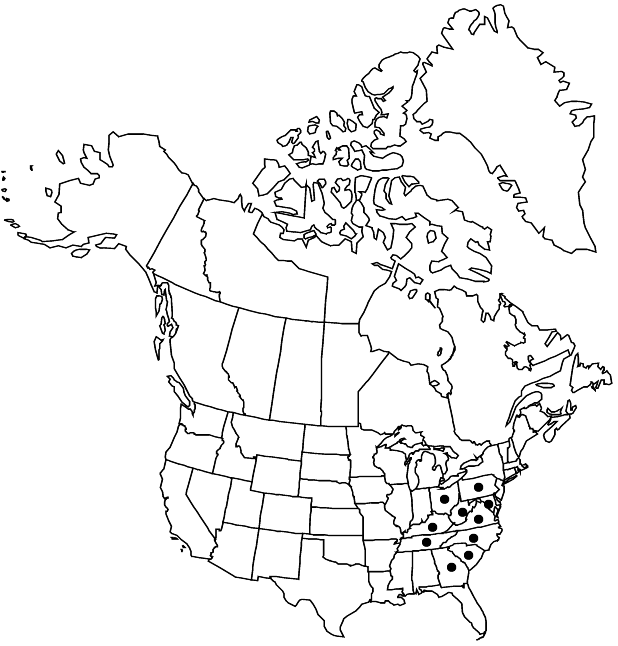Rhododendron calendulaceum
Fl. N. Middle United States, 425. 1824 ,.
Shrubs or trees, to 4(–10) m, usually not rhizomatous. Stems: bark smooth to vertically furrowed, shredding; twigs sparsely to conspicuously multicellular eglandular-hairy (hairs unbranched), otherwise sparsely to moderately unicellular-hairy. Leaves deciduous; petiole multicellular eglandular-hairy and unicellular-hairy; blade ovate to obovate, 4.5–9.1 × 1.3–3.3 cm, thin, membranous to chartaceous, margins entire, plane, ciliate, eglandular-hairy, apex acute to obtuse, often mucronate, abaxial surface glabrous or densely eglandular-hairy, often also very sparsely to moderately unicellular-hairy, adaxial surface glabrous or sparsely scattered eglandular-hairy, often also sparsely unicellular-hairy. Floral bud scales usually glabrous abaxially, margins glandular. Inflorescences 5–9-flowered; bracts similar to bud scales. Pedicels 7–14 mm, stipitate-glandular-hairy and/or eglandular-hairy, otherwise sparsely to densely unicellular-hairy. Flowers opening before or as leaves expand, erect to horizontal, acrid-scented; calyx lobes 1–3 mm, scattered usually stipitate-glandular-hairy and unicellular-hairy, margins long stipitate-glandular-hairy and/or eglandular-hairy; corolla orange to red-orange, with contrasting, darker-colored, orange to yellow blotch on upper lobe, funnelform, 30–54 mm, densely multicellular stipitate-glandular-hairy, otherwise sparsely to densely unicellular-hairy on outer surface, petals connate, lobes 14–30 mm, (spreading nearly as broadly as tube is long), tube abruptly expanding into lobes, 16–28 mm (longer than lobes); stamens 5, much exserted, ± unequal, 52–72 mm. Capsules borne on erect pedicels, 15–29 × 5–9 mm, sparsely to moderately long stipitate-glandular-hairy and/or eglandular-hairy, and sparsely unicellular-hairy. Seeds without distinct tails, flattened portion of testa well developed at each end; testa expanded, dorsiventrally flattened, ± loose. 2n = 52.
Phenology: Flowering spring–summer.
Habitat: Mixed deciduous forests
Elevation: 200-1000 m
Distribution

Ga., Ky., Md., N.C., Ohio, Pa., S.C., Tenn., Va., W.Va.
Discussion
Rhododendron calendulaceum, frequently confused with the diploid R. cumberlandense, is an allotetraploid, and may have been derived from a hybrid between an ancestor of R. cumberlandense and one of R. prinophyllum (K. A. Kron 1993). It is distinguished from R. cumberlandense by its flowers opening before or with (versus after) the expansion of the leaves, glandular or eglandular (versus usually eglandular) pedicels, glandular or eglandular (versus usually eglandular) sepal margins (R. cumberlandense never with both pedicels and sepal margins glandular), and nonglaucous (versus often glaucous) abaxial leaf surface. Rhododendron calendulaceum is one of the showiest shrubs of the southern Appalachians; it is known to hybridize with R. prinophyllum and R. canescens.
Rhododendron calendulaceum and the remaining species (through 25. R. eastmanii) are the North American representatives of sect. Pentanthera G. Don, a group characterized by corollas that are typically unicellular-hairy on the outside and with a narrow tube, flowers with five, declinate, and usually much-exserted stamens, and seeds with ± loose testae (K. A. Kron 1993; Kron and M. Creel 1999). All species are used as ornamentals because of their colorful flowers(F. C. Galle 1985).
Selected References
None.